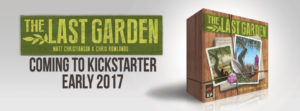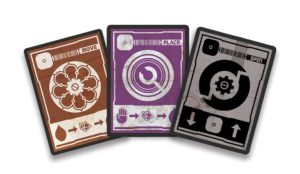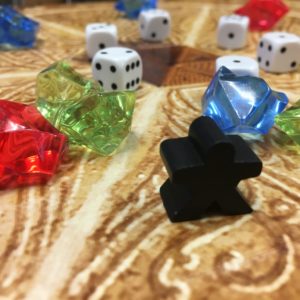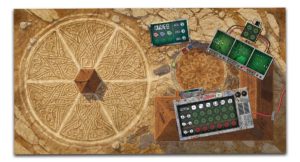The Last Garden, a beautiful looking game with art by the talented Beth Sobel and designed by Chris Rowlands and Matt Christianson, is funding on Kickstarter February 21. We had the wonderful honor to talk to Chris and Matt about it.
Where did you guys get the inspiration for making The Last Garden?
Matt:
Oddly enough, it all started with a weird dream. A dream that was about putting hot glue drops on fake flowers to simulate dew, you know, the kinds from craft stores and such. At the time I was in in full board game design mode and thought I would challenge myself to try and make a game about these faux flowers. So, naturally I cut out some paper flower petals and started placing glass beads on them to try and make it resemble a game.
Chris:
Matt had originally called the game Glue Gun Dew Drops, and we all sort of laughed at the theme. After playing the game though, we thought the bones were really fun so we tried to figure out why somebody would be doing something like this.
Matt:
We are huge fans of Mad Max movies and after watching The Road Warrior for the hundredth time, I had this crazy idea of a malicious Queen ruling over a barren waterless land and making her minions create flower gardens from scraps and mined gems. Chris and I felt it was a bit dark, and came up with an awesome idea of giving it more of a Pixar feel with a loving Queen surrounded by these old mining robots she calls Robotanists. Her Robotanists are programmed to help build the Gardens from her memories as a young child, and because the world has no more moisture they are doing it with scavenged metal and gems.
Chris:
Somewhere in there is commentary about consumption. This idea that when the world ends these valuable gems just become something else to look at. The story evolved into being something very cool: this badass elderly woman trying to bring something beautiful back into the world. We loved the idea that she isn’t doing this for somebody else, she’s just doing it to do it. It’s really exactly the type of game we wanted to make when we started our publishing company One Thousand XP – a game that hints at a larger world and that will inspire folks’ imaginations. What happened? Why is the world like this? Who was this woman before she was Queen? These are all things that we want people to wonder about.
What happens in this game?
Matt:
The Last Garden can play with 2 – 4 players, and each player will control a group of Robotanists. It is your job as Robotanists to create The Queen’s vision of the gardens from her youth. It is a little abstract in that gems represent the many flowers being built within the gardens. Play starts by a player playing a card that will manipulate the garden somehow, either by adding gems, moving gems or changing garden numbers. Then you place a Robotanist, worker placement style, upon the board to either score Favor Points or download new programs which boost your cards. Play continues until a number of rounds are played and the player with the most Favor Points wins. Each Robotanist team is competing with one another to become The Queen’s favorites, so there is a take-that element to the game as the garden gets shifted around.
Chris:
Yeah the Robotanists aren’t the best at what they do, and the Queen is constantly changing her mind about what she wants so everything is constantly in flux. Because of that, players can really interfere with one another and get in each other’s way. It ends up being a really cool mix of worker placement and direct interaction.
How does the betting/wagering work in The Last Garden?
Matt:
The betting and wagering aspect of The Last Garden was inspired by many nights of us playing rowdy games of Camel Up and our experience with casino games such as Roulette and Craps. Except, instead of chips and luck we use Robotanists and the worker placement mechanic to make attempts to get that “Jackpot” of Favor Points. Now it is not necessarily a gamble, as you do get to manipulate your bets by playing cards to swing the game in your favor.
Chris:
From Camel Up, we really liked the idea of being able to participate in different ways. You can send Robotanists to the mines and they will score favor based on the color of gems, or you can send a Robatinst to work directly in the garden and score favor based on how many gems are in that area. There is also a luck-pushing element that we call “wilting.” If there are too many gems on a single location the Queen will think it looks to gaudy, so she’ll have the Robotanists remove all of the gems and start over the next day. Because of that, you need to be careful about putting too much work into an area that your opponents can make wilt. It’s really a very tactical game, where you’ll need to constantly readjust your strategy to fit the current situation.
To win this game, the player’s Robotanists must get the most favor from the queen. Is that whomever gets closest to what the Queen wants for the last garden? Does how the last garden looks change per game played?
Matt:
The Queen’s favor in The Last Garden is represented by something we call Favor Points, and these points are tracked by tokens that each player keeps hidden from round to round. Players will earn Favor Points based on where their Robotanists are placed upon the board and at the end of the game the player with most wins. In the story of the Last Garden, The Queen’s childhood memories are a little clouded and she cannot remember exactly what the gardens look like. So yes, the final result of how the garden looks changes from game to game.
Chris:
In addition, the garden is not reset between rounds, so each game will play different from the previous one. There are games where a wilting happens in the first round and the rest of the game is trying to fight over the few remaining gems, and there are games where there is never a wilt and there are a ton of gems in the garden.
You were able to get the great artist Beth Sobel to work on The Last Garden. What was the inspiration for the art involved in the game?
Matt:
Yes indeed! Beth is an amazing artist and one of most kind human beings I have ever met. First of all, we all live in the same state which is awesome, and we go to the same board game conventions which leads us to where we met. Chris had interacted with Beth on social media, and then we had the opportunity to meet Beth in person at a local convention called Orcacon. Both of us are fans of her artwork, her portrayal of people are remarkable! We ended up playing some games together at the convention and asked if she wanted to do the artwork for The Last Garden. It was really exciting for us when she accepted. So, the inspiration for the art were from Mad Max movies with a whimsical Pixar vibe and the idea of potential hidden beauty within a desolate wasteland. There is a somber note in that The Queen is the last known human on this world, but she not necessarily alone in her endeavor. Her Robotanists are there to keep her company.
Chris:
To be honest, we met Beth and thought to ourselves “she would be a pleasure to work with someday” but we really didn’t think of her for The Last Garden. When we explained the theme to her she really liked it, and then Matt and I sort of looked at each other and were like “well, it couldn’t hurt to ask!” We’re first-time publishers, and couldn’t have asked for a better artist to work with for our first project. We gave her some references, but her work totally took our world to the next level. She also gets all the credit for the trompe l’oeil style of the box, and it turned out so great.
With so many games being Kickstarted these days, what makes The Last Garden unique?
Chris:
One of the biggest elements that I think sets The Last Garden apart from other campaigns is that this is truly a throwback to the earlier days of Kickstarter. The Last Garden is a labor of love, and we know that the theme is going to be a big departure from what people are used to. Without Kickstarter, we’re sure that the game couldn’t exist in it’s current iteration. The theme is too weird! To be honest, we had a publisher that was interested in the game, but they were very hesitant about the theme and wanted to restructure it. Eventually Matt and I decided that we would try and make the game true to what we wanted to make, and we’re excited that Kickstarter exists as a way for interesting and quirky projects to become reality.
Matt:
The Last Garden also has a very unique gameplay to it, unlike any we have ever played or designed. Sure some of the mechanics may feel familiar, but the way they meld together works really well. We’re a small team, so it took over a year of extensive playtesting to fine tune the mechanics to where they finally felt seamless. I think that visually the game is striking and the gameplay is fun and satisfying.
What are your pledge levels going to look like for The Last Garden?
Chris:
Pledge level, singular. We’re probably only going to have one. That could change, but right now we really like the idea of a single level that gets you the game and some promos. We have some stretch goals planned, but most of them are really about getting component upgrades. I don’t know, it just really feels like so many Kickstarter campaigns have so many bells and whistles and we don’t want to complicate things. We want to make this really fun and quirky game for you, we’re super passionate about it, and we need your help to do it. That’s it. One reward level seems like the most straightforward way to do that.
We had a great time with this interview and we’re STOKED to see this game gets funded! There’s one way you can help out: GO TO KICKSTARTER https://www.kickstarter.com/projects/npcchris/the-last-garden-robotanists-in-the-post-apocalypse?ref=nav_search AND HELP THIS GAME BECOME A REALITY!
Thanks to Chris Rowlands and Matt Christianson for a great interview!
Thanks to you for reading!








